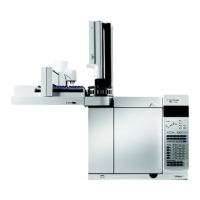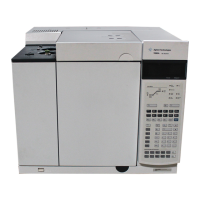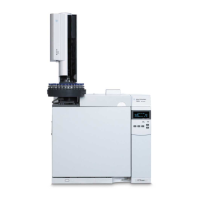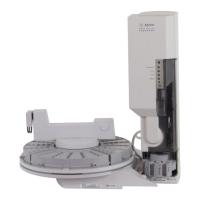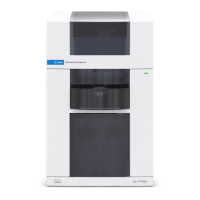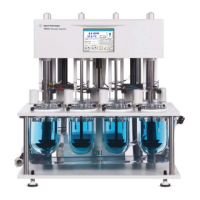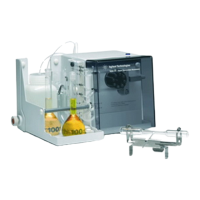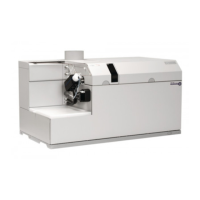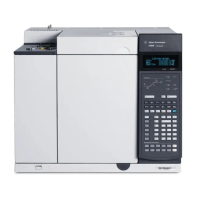
Do you have a question about the Agilent Technologies 7890B and is the answer not in the manual?
| Brand | Agilent Technologies |
|---|---|
| Model | 7890B |
| Category | Laboratory Equipment |
| Language | English |
Explains the fundamental steps of gas chromatography using a GC system.
Describes the GC's operating panel: display, status lights, keypad, beeping, and blinking setpoints.
Outlines the various tasks involved in operating the Agilent 7890B GC.
Explains GC control via data system or keypad, including method/sequence loading.
Provides step-by-step instructions for starting up the Agilent 7890B GC.
Details the procedure for safely shutting down the GC for short periods.
Outlines the steps for a complete shutdown of the GC for extended periods.
Guides users on identifying and resolving common GC operational issues and fault messages.
Explains the function of keys used to start, stop, and prepare the GC for sample runs.
Describes keys for setting temperature, pressure, flow, and other operational parameters for GC components.
Details how to use the Status key to view status and customize display order.
Explains how the Info key provides context-sensitive help for parameters, showing valid ranges or actions.
Covers keys used for inputting data, clearing entries, navigating displays, and making selections.
Describes keys for time display, post-run programming, accessing logs, options, and configuration.
Explains keys for loading/storing methods and sequences locally on the GC for automation.
Outlines how the keypad functions for status viewing and basic operations when an external data system controls the GC.
Details the Service Mode key for setup, leak checks, and accessing advanced service settings.
Explains GC status indicators, including status board LEDs, alert tones, and error conditions.
Describes access to run, maintenance, and system event logs for operational tracking and GLP support.
Defines a GC method as a set of settings for analyzing a specific sample.
Lists parameters saved in a method, including temperature programs, gas types, and inlet/detector settings.
Explains the effect of loading active and stored methods on GC setpoints and readiness.
Details the process of creating a GC method by saving setpoints for components.
Defines a sequence as a list of samples to be analyzed with associated methods, including priority and post-sequence events.
Explains how to create sequences, including priority, subsequences, and post-sequence events.
Describes how data systems automate analysis, method development, and sequence creation via digitized detector output.
Explains how to load, run, and abort methods using the GC keypad, including manual and ALS injections.
Details how to load, start, pause, stop, and abort sequences using the GC keypad.
Provides an overview of tests to confirm GC and detector performance against factory standards.
Lists recommended parts and preparation steps for performing checkout tests on inlets and consumables.
Details the procedure for verifying the performance of the Flame Ionization Detector (FID), including baseline output.
Outlines the steps for checking the performance of the Thermal Conductivity Detector (TCD), including baseline output.
Provides instructions for verifying the performance of the Nitrogen Phosphorus Detector (NPD), including output specifications.
Describes the procedure for checking the performance of the Ultra-electron Capture Detector (uECD), including baseline output.
Details checking FPD+ performance for phosphorus and sulfur using a specific sample and related filters.
Covers FPD+ performance checks for phosphorus and sulfur with a Japanese sample and related filters.
Outlines FPD performance checks for phosphorus and sulfur using a specific sample and related filters.
Details FPD performance checks for phosphorus and sulfur with a Japanese sample and related filters.
Explains how the GC uses an instrument schedule to conserve resources like electricity and gases.
Describes creating sleep methods to reduce gas and power usage during inactive periods, considering detectors and columns.
Details methods for waking the GC from sleep or conditioning it for operation, specifying restore options.
Guides on creating and using an Instrument Schedule for resource conservation, including wake/condition choices.
Explains how to edit, delete, or add items to the GC's instrument schedule for automated operations.
Provides steps for creating or modifying sleep, wake, and condition methods, noting parameter limitations.
Instructs on how to manually put the GC into a low-power sleep state via the instrument schedule.
Explains the options for waking the GC from a sleep state, including restoring methods or running condition methods.
Introduces EMF counters for tracking consumable usage and maintenance needs to prevent performance degradation.
Differentiates between injection and time-based counters for GC components and their tracking logic.
Explains the two warning thresholds (Service Due, Service Warning) for EMF counters and their independent setting.
Describes using default thresholds as a starting point for EMF counter settings and adjusting them based on application.
Lists common EMF counters available for various GC components and parts, noting variability based on installed options.
Guides on enabling or modifying limits for EMF counters using the GC keypad and selecting threshold values.
Provides steps to disable specific EMF counters on the GC by setting their thresholds to 'Off'.
Explains how to reset an EMF counter to zero after maintenance or when a Service Due threshold is passed.
Details EMF counter functionality for Agilent autosampler systems, depending on model and firmware version.
Explains how EMF counters are tracked by the GC or the MS itself when connected to an MS instrument.
Describes how the GC and MS instrument communicate and interact, focusing on venting and shutdown events.
Explains the process and GC behavior during MSD venting, including flow adjustments and state management.
Lists events that trigger an MS shutdown in the GC and the GC's response, such as aborting runs and setting temperatures.
Details creating a specific method for safely venting the Mass Spectrometer, including temperature and flow settings.
Explains how to manually load the MS Vent method for preparing the GC for venting.
Provides instructions for exiting the MS Vent state manually, with CAUTIONary notes on flow settings.
Guides on using the GC when the MSD is offline for maintenance or repair, including disabling communications.
Explains how to control communication between the GC and the MS via the Aux Det settings.
Introduces the two-part configuration process for GC accessory devices: assigning resources and setting properties.
Details assigning power and communication resources to GC accessory devices, changing their state from Unconfigured to Configured.
Explains how to set constant hardware setup properties for configured devices, like gas type and temperature limits.
Covers unlocking GC configuration and the Ignore Ready parameter for readiness determination.
Describes oven parameters like temperature limits, equilibration time, cryo cooling, and slow cool down modes.
Covers configuring gas type and coolant settings for front and back inlets, including PTV/COC coolant options.
Details parameters for defining capillary column properties like length, diameter, film thickness, and inlet/outlet connections.
Explains configuring composite columns with multiple segments and heating zones, specifying lengths for each.
Describes configuration for Low Thermal Mass (LTM) columns and LTM Series II modules, noting parameter limitations.
Covers configuration of a cryo trap, including its connection to GC, heater, coolant, and user-configurable parameters.
Details configuring makeup/reference gas, lit offset, and FPD heaters for various detectors.
Explains configuring analog output speeds and using the fast peaks feature for detector data output.
Covers assigning GC power to valve box heaters and their temperature control configuration.
Details assigning power to auxiliary thermal zones and configuring specific heater types like MSD, nickel catalyst, and AED.
Explains configuring Pressure Control Modules (PCM), including gas type, mode, and channel settings.
Details assigning GC communication sources to Aux EPC modules and configuring pressure channels with gas types.
Covers the ready/not ready status table and configuring the order of the setpoint status table.
Explains setting the GC's time and date, including time zone, and using the stopwatch function.
Details configuring valves, including sampling, switching, multiposition types, and remote start options.
Covers sampler recognition and configuration for 7693A, 7650A, and 7683 ALS systems, including tower positions.
Explains configuring the 7683 ALS sample tray, including grip offset and barcode reader settings for data input.
Covers instrument serial number entry, auto prep run, zeroing data files, and host connection requirements for readiness.
Describes using barcode readers for inputting configuration data, their power, installation, and scanning procedures.
Introduces the Options menu for functions usually set on installation and seldom changed afterward.
Explains calibration procedures for EPC modules, flow/pressure sensors, columns, and other GC components.
Details configuring the GC's IP address for network (LAN) operation, including DHCP and manual IP settings.
Covers keyboard lock, key click, warning beeps, radix type, display saver, and language settings for user interface customization.
